Asked about the topic, Rome’s chief curator of cultural heritage, Claudio Parisi Presicce, said Usmanov’s funding was agreed before Western sanctions, and Rome’s ancient heritage, he says, is “universal”.
The imposing colonnade of Trajan’s Basilica in Rome, which occupies a prominent position in the Roman emperor’s forum a stone’s throw from the Colosseum, has just been partially restored thanks to a Russian oligarch under sanctions from the European Union and the United States, AFP reported.
While most of the projects undertaken in Rome to bring the ancient ruins to light force tourists to stoop, the reconstruction of the two-story Corinthian colonnade invites them to look up at the sky, at a height of more than 23 meters.
“If visitors don’t perceive the height of the monuments, they don’t understand the significance of the architecture,” Claudio Parisi Presicce, Rome’s chief curator of cultural heritage, told AFP during a visit to the site.
The Basilica of Ulpia, a building with no religious vocation at the time, is the centerpiece of the Forum of Trajan, the largest and last of the imperial forums, named after Marcus Ulpius Trajan, emperor from 98 to 117 AD.
Discovered in the second century, it largely collapsed in the Middle Ages, but was brought to light by excavations in the early 19th century and in the 1930s.
The current project, which began in 2021, made it possible to identify three green marble columns left for almost a century “in a corner”, without connection to their foundations, explains Presicce.
The project was funded by a €1.5 million donation made in 2015 by Uzbek-born oligarch Alisher Usmanov.
He was sanctioned by the European Union and the US after Russia’s invasion of Ukraine in early 2022, accused by the US Treasury Department of being close to Russian President Vladimir Putin.
Last year, Forbes magazine estimated the fortune of the oligarch at $14.4 billion.
Named “most generous donor” in the 2021 Sunday Times list of wealthy philanthropists, having given away £4.2 billion over 20 years. dollars for charity, Usmanov is a noted Italophile from whose generosity Rome has already benefited.
Asked about the topic, Claudio Parisi Presicce replied that Usmanov’s financing was agreed before the Western sanctions, and the ancient heritage of Rome, according to him, is “universal”.
Trajan’s large-scale military campaigns, including the virtual extermination of the Dacians in present-day Romania, allowed Rome to expand its borders even further.
His two bloody wars against the Dacians are represented by a spiral bas-relief on Trajan’s Column, located north of the basilica and erected in celebration of the emperor’s victories and booty.
“Trajan built a monument using the most precious materials that could be found at the time,” Parisi Presicce, referring to the colored marble quarried in Egypt, Asia and Africa.
The basilica, which housed the civil and criminal courts and other administrative structures, consists of five central aisles separated by rows of columns.
Designed by the famous architect Apollodorus of Damascus, it has a roof of bronze tiles, while the facade is decorated with statues of Dacian prisoners and frescoes depicting the weapons of the victorious legions.
Previous excavations had brought to light the forum and the remains of its basilica, but although the massive granite columns running the length of the basilica had been restored and reassembled, the colonnade still lacked its second floor.
This has already been done: segments of the original marble of the frieze of the entablature, preserved in warehouses or museums, have been recreated in resin, as well as lost parts with less detail.
This allows the visitor to see the difference between the originals and the replicas – a common practice in heritage-conscious restoration and illustrating the reversible nature of intervention.
The final stages of the project include the re-creation of the basilica’s southern staircase, using slabs of ancient yellow marble found at the site.
Around 150 archaeological projects are planned in Rome until 2027, the majority of which are financed by the European Union’s post-pandemic recovery funds.
Photo: Marcus Ulpius Traianus, Marble bust, Glyptothek, Munich












